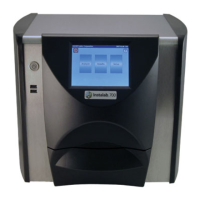Why does Dickey-John Instalab 700 NIR Measuring Instruments say flash drive required?
- PPatrick CruzSep 12, 2025
A flash drive must be inserted before proceeding on Dickey-John Measuring Instruments.

Why does Dickey-John Instalab 700 NIR Measuring Instruments say flash drive required?
A flash drive must be inserted before proceeding on Dickey-John Measuring Instruments.
What to do if Dickey-John Instalab 700 NIR says Customer ID is required?
If your Dickey-John Measuring Instruments require a Customer ID, it must be entered before proceeding.
| Display | LCD screen |
|---|---|
| Measurement Method | Near-Infrared (NIR) Spectroscopy |
| Technology | NIR |
| Measurement Parameters | Moisture, Protein, Oil, Starch, Fiber, and others |
| Applications | Grain, Food, and other agricultural products |
| Data Storage | Internal memory, external storage via USB |
| Connectivity | USB |
| Power Supply | 100-240V AC |
| Measurement Range | Dependent on application and calibration |
| Sample Presentation | Solid samples in a cup |
| Measurement Time | Approximately 60 seconds |
Overview of the main components of the Instalab 700.
Details the directives and regulations the IL700 conforms to.
Lists the key features and capabilities of the IL700.
Lists the technical specifications and operating parameters of the IL700.
Lists and describes the tools included with the IL700.
Lists and describes optional accessories available for the IL700.
Guidelines for positioning the instrument for optimal operation and safety.
Details the various ports for connecting external devices and networks.
Using pre-developed calibrations with bias adjustment for common products.
Process of adjusting instrument bias to match reference lab results.
Steps and considerations for developing unique calibration models.
Key steps in collecting representative samples for calibration development.
Number of samples needed for accurate calibration and testing.
Best practices for collecting samples from the process for calibration.
How product attributes like color and hardness affect calibration.
Importance of moisture content and its effect on constituent analysis.
Proper procedures for storing samples to maintain integrity before analysis.
General process for creating and refining calibration models.
Procedure for collecting raw data for calibration development.
Procedures for preparing dry powder samples, including grinding and mixing.
Methods for preparing semi-liquid and solid samples using open cups.
Instructions for preparing liquid samples using the specialized liquid sample cup.
Steps to install and use the optional large open sample cup.
How to connect and use external devices like keyboards and mice.
Explains the purpose and operation of various on-screen buttons.
Procedure for recalibrating the touch screen for better responsiveness.
Description of the virtual keypad for text entry on the touch screen.
How to maintain the unit in open access mode using default credentials.
Steps to create or change administrator credentials for secure access.
Managing product profiles, including editing, copying, deleting, and importing.
Customizing unit functionality, print settings, and system upgrades.
Configuring printer connections and output formats for test results.
Enabling and configuring serial data streaming for output.
Customizing print tickets with header and footer information.
Recommended printer configurations for optimal performance.
Configuring sample and customer ID requirements for test results.
Exporting and restoring system configuration files via USB.
Setting and adjusting the unit's internal clock and date.
Entering owner information used for print ticket headers/footers.
Importing and selecting user interface languages for the unit.
Viewing and managing system event logs for troubleshooting.
Configuring network settings for Ethernet connectivity.
Describes the sequence of screens displayed during unit power-on.
Procedures for safely shutting down and restarting the instrument.
Overview of the primary interface for accessing unit functions.
Explains the temperature indicator and its significance for analysis.
Description of the sample drawer's sections and function.
Steps to choose a product for analysis from the available list.
Guides through the screens involved in the analysis process.
Displays and explains the output of a completed product analysis.
Defines common terms and readings found in analysis results.
Procedure for collecting raw data for calibration development.
Displays a summary list of all stored test results.
Filters and searches for specific test results based on criteria.
Filtering results by a specific count of the most recent tests.
Filtering results based on a specified number of past days.
Searching results by entering the specific name of the product tested.
Filtering results by a specific customer identifier.
Removes all stored test results from the unit's database.
Backs up all records to USB before deleting them from the unit.
Measuring and analyzing raw log values for each filter.
Tracking and monitoring drift in reference log values over time.
Identifying installed filters and their corresponding wavelengths.
Displaying current machine voltage values for troubleshooting.
Monitoring filter compartment and detector temperatures for troubleshooting.
Re-calibrating the touch screen display for improved responsiveness.
Accessing a collection of diagnostic data for troubleshooting.
Performing a noise test for troubleshooting purposes.
Illustrates an example error message and its resolution.
A table listing common errors, probable causes, and corrective actions.
Procedure for inspecting and cleaning or replacing the unit's air filter.
Steps for cleaning the reference disk and sample drawer assembly.
Instructions for cleaning the aperture glass above the reference disk.
A worksheet template for performing bias adjustments.
Explains the importance and types of moisture basis in NIR calibrations.
Details the common moisture basis selections for NIR constituent calibration.
Illustrates methods of expressing protein using diagrams and formulas.
Explains the mathematical relationship between constituents and moisture.
Discusses calibration development formats and moisture basis implications.
Automatic setting of overall signal gain in the IL700.
How mode gains can be adjusted and their impact on sample measurements.
Automating data extraction and analysis via computer.
Manipulating files on the IL700 using FTP commands.
Example format for data streaming, including placeholders for constituents.
